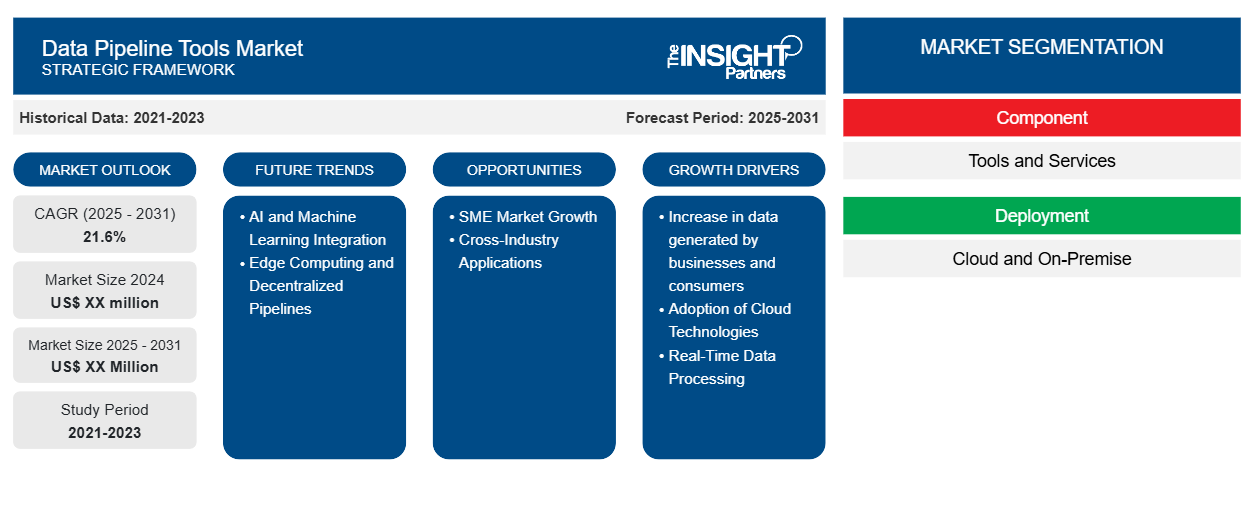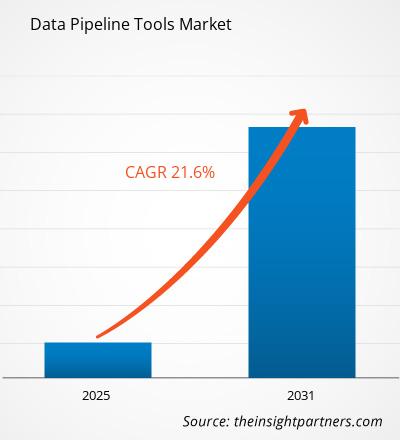The Data Pipeline Tools Market is expected to register a CAGR of 21.6% from 2025 to 2031, with a market size expanding from US$ XX million in 2024 to US$ XX Million by 2031.
The report is segmented By Component (Tools and Services), By Deployment (Cloud and On-Premise), By Enterprise Type (SMEs and Large Enterprise), By Industry (BFSI, IT & Telecom, Healthcare, Marketing & Advertising, Manufacturing, and Others). The global analysis is further broken-down at regional level and major countries. The report offers the value in USD for the above analysis and segments
Purpose of the Report
The report Data Pipeline Tools Market by The Insight Partners aims to describe the present landscape and future growth, top driving factors, challenges, and opportunities. This will provide insights to various business stakeholders, such as:
- Technology Providers/Manufacturers: To understand the evolving market dynamics and know the potential growth opportunities, enabling them to make informed strategic decisions.
- Investors: To conduct a comprehensive trend analysis regarding the market growth rate, market financial projections, and opportunities that exist across the value chain.
- Regulatory bodies: To regulate policies and police activities in the market with the aim of minimizing abuse, preserving investor trust and confidence, and upholding the integrity and stability of the market.
Data Pipeline Tools Market Segmentation
Component
- Tools and Services
Deployment
- Cloud and On-Premise
Enterprise Type
- SMEs and Large Enterprise
Industry
- BFSI
- IT & Telecom
- Healthcare
- Marketing & Advertising
- Manufacturing
You will get customization on any report - free of charge - including parts of this report, or country-level analysis, Excel Data pack, as well as avail great offers and discounts for start-ups & universities
Data Pipeline Tools Market: Strategic Insights

-
Get Top Key Market Trends of this report.This FREE sample will include data analysis, ranging from market trends to estimates and forecasts.
Data Pipeline Tools Market Growth Drivers
- Increase in data generated by businesses and consumers: The exponential increase in data generated by businesses and consumers is a major driver of the data pipeline tools market. Organizations need efficient tools to process, analyze, and store vast amounts of data in real time. Data pipeline tools allow for seamless integration, transformation, and transportation of data, ensuring businesses can utilize this data for insights, decision-making, and operational efficiency.
- Adoption of Cloud Technologies: The shift towards cloud-based infrastructures accelerates the demand for data pipeline tools. Cloud environments offer scalability, flexibility, and cost efficiency, and businesses are increasingly relying on cloud-native data pipelines to manage and process large datasets across distributed systems. This shift is fostering a greater need for automated data workflows that can be managed across cloud platforms.
- Real-Time Data Processing: The growing importance of real-time analytics in industries such as finance, e-commerce, and healthcare is driving the need for faster, more robust data pipelines. Real-time data processing tools enable organizations to make timely, data-driven decisions, improving agility and competitive advantage.
Data Pipeline Tools Market Future Trends
- AI and Machine Learning Integration: As data pipelines become more complex, the integration of AI and machine learning (ML) is expected to play a central role in future data pipeline tools. These advanced technologies will enhance the automation of data processing tasks, optimize data workflows, and enable predictive analytics. AI and ML will empower organizations to automate decision-making, anomaly detection, and improve data quality, driving smarter and more efficient data operations.
- Edge Computing and Decentralized Pipelines: With the rise of IoT devices and the growing need for low-latency processing, edge computing is becoming increasingly relevant. Future data pipeline tools will evolve to support decentralized architectures where data is processed closer to the source, reducing latency and bandwidth requirements. This trend will enable businesses to manage and analyze data in real time at the edge, benefiting industries like manufacturing, automotive, and healthcare.
Data Pipeline Tools Market Opportunities
- SME Market Growth: Small and medium-sized enterprises (SMEs) are increasingly recognizing the value of data analytics and are seeking cost-effective, scalable data pipeline tools. Vendors have the opportunity to target this underserved market by offering user-friendly, affordable solutions tailored to the needs of smaller organizations. This opens up new avenues for growth as SMEs adopt advanced data practices without requiring substantial infrastructure investments.
- Cross-Industry Applications: Data pipeline tools can serve a broad range of industries, including finance, healthcare, retail, and logistics. The opportunity lies in creating industry-specific solutions or customizable platforms that address the unique challenges each sector faces with data processing. By providing tailored, specialized solutions, companies can expand their reach and grow their customer base while addressing the complex data needs of diverse industries.
Data Pipeline Tools Market Regional Insights
The regional trends and factors influencing the Data Pipeline Tools Market throughout the forecast period have been thoroughly explained by the analysts at The Insight Partners. This section also discusses Data Pipeline Tools Market segments and geography across North America, Europe, Asia Pacific, Middle East and Africa, and South and Central America.
Data Pipeline Tools Market Report Scope
| Report Attribute | Details |
|---|---|
| Market size in 2024 | US$ XX million |
| Market Size by 2031 | US$ XX Million |
| Global CAGR (2025 - 2031) | 21.6% |
| Historical Data | 2021-2023 |
| Forecast period | 2025-2031 |
| Segments Covered |
By Component
|
| Regions and Countries Covered |
North America
|
| Market leaders and key company profiles |
|
Data Pipeline Tools Market Players Density: Understanding Its Impact on Business Dynamics
The Data Pipeline Tools Market is growing rapidly, driven by increasing end-user demand due to factors such as evolving consumer preferences, technological advancements, and greater awareness of the product's benefits. As demand rises, businesses are expanding their offerings, innovating to meet consumer needs, and capitalizing on emerging trends, which further fuels market growth.

- Get the Data Pipeline Tools Market top key players overview
Key Selling Points
- Comprehensive Coverage: The report comprehensively covers the analysis of products, services, types, and end users of the Data Pipeline Tools Market, providing a holistic landscape.
- Expert Analysis: The report is compiled based on the in-depth understanding of industry experts and analysts.
- Up-to-date Information: The report assures business relevance due to its coverage of recent information and data trends.
- Customization Options: This report can be customized to cater to specific client requirements and suit the business strategies aptly.
The research report on the Data Pipeline Tools Market can, therefore, help spearhead the trail of decoding and understanding the industry scenario and growth prospects. Although there can be a few valid concerns, the overall benefits of this report tend to outweigh the disadvantages.
Frequently Asked Questions
What are the options available for the customization of this report?
What are the deliverable formats of the market report?
What are the future trends of the data pipeline tools market?
What are the driving factors impacting the global data pipeline tools market?
What is the expected CAGR of the data pipeline tools market?
- Historical Analysis (2 Years), Base Year, Forecast (7 Years) with CAGR
- PEST and SWOT Analysis
- Market Size Value / Volume - Global, Regional, Country
- Industry and Competitive Landscape
- Excel Dataset
Recent Reports
Related Reports
Testimonials
Reason to Buy
- Informed Decision-Making
- Understanding Market Dynamics
- Competitive Analysis
- Identifying Emerging Markets
- Customer Insights
- Market Forecasts
- Risk Mitigation
- Boosting Operational Efficiency
- Strategic Planning
- Investment Justification
- Tracking Industry Innovations
- Aligning with Regulatory Trends






















 Get Free Sample For
Get Free Sample For